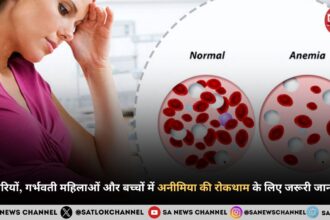Heart Attack vs Cardiac Arrest: Heart-related emergencies can strike suddenly and demand immediate action. Yet, many people still confuse two of the most serious conditions, heart attack and cardiac arrest. Though they may sound similar, they are entirely different in cause, effect, and response. Knowing the difference could literally save a life.
- Key points Understanding Heart Attack and Cardiac Arrest
- Heart Attack: When Circulation Stops
- Cardiac Arrest: When the Heart Stops Completely
- How They Are Connected
- Expert Explanation: The House Analogy
- Recognizing the Warning Signs
- What To Do in a Heart Emergency
- When Every Second Matters
- The Final Word: Awareness Can Save Lives
- Spiritual Insight – The Divine Power of Tatvdarshi Sant Rampal Ji Maharaj Ji
- FAQs on Heart Attack vs Cardiac Arrest
Mumbai-based orthopaedic surgeon Dr. Manan Vora explained this distinction through a simple yet powerful analogy, while trusted medical authority Heart.org detailed the biological and emergency aspects behind both conditions. Here’s a comprehensive look at what sets them apart and why every second counts during such critical moments.
Key points Understanding Heart Attack and Cardiac Arrest
1. Heart attack is a circulation problem, caused by blocked arteries that stop blood flow to parts of the heart.
2. Cardiac arrest is an electrical problem, where the heart suddenly stops beating due to rhythm disturbance.
3. Heart attack patients are usually conscious, but cardiac arrest causes instant collapse and loss of pulse.
4. Heart attacks increase the risk of cardiac arrest, especially during recovery.
5. Immediate CPR and defibrillation can double or triple survival chances in cardiac arrest cases.
6. Calling emergency services right away is vital, every minute of delay can cost a life.
Heart Attack: When Circulation Stops
A heart attack occurs when a blocked artery prevents blood from reaching a section of the heart. If this blockage isn’t cleared quickly, the heart muscle begins to die. The longer the heart is deprived of blood, the greater the damage.
Symptoms may appear suddenly and intensely or develop gradually with mild discomfort. Some individuals may even experience a “silent heart attack”, showing few or no signs. Common symptoms include chest pain, dizziness, and nausea.
Unlike cardiac arrest, the heart usually keeps beating during a heart attack. However, delayed treatment can turn a heart attack into a life-threatening emergency.
Cardiac Arrest: When the Heart Stops Completely
In contrast, cardiac arrest is a sudden electrical failure in the heart. It causes an irregular rhythm or arrhythmia that stops the heart from pumping blood to the brain, lungs, and other vital organs. Within seconds, the person loses consciousness and pulse.
If not treated immediately, death can occur within minutes. Sudden cardiac arrest often strikes without warning, making it one of the most dangerous medical emergencies.
According to Heart.org, approximately 350,000 out-of-hospital cardiac arrests occur in the United States every year. Immediate CPR (cardiopulmonary resuscitation) and the use of a defibrillator (AED) can double or even triple the chances of survival.
How They Are Connected
Though different in nature, heart attack and cardiac arrest are closely linked.
A heart attack can trigger cardiac arrest, either immediately or during recovery. The damage from a heart attack increases the risk of the heart’s rhythm becoming unstable.
Also Read: Using Your Phone in the Bathroom? Scientists Warn of a Hidden Gut Health Danger You Shouldn’t Ignore
However, not every heart attack leads to cardiac arrest. Other conditions such as cardiomyopathy, heart failure, congenital defects, infections, or severe arrhythmias like ventricular fibrillation can also disrupt the heart’s electrical system and cause sudden arrest.
Expert Explanation: The House Analogy
In a viral educational video, Mumbai-based surgeon Dr. Manan Vora orthopaedic surgeon, health educator, and NutriByte Wellness co-founder is explaining:
“To understand the difference, imagine the heart is a house and the blood flowing is the plumbing system, the pipes and taps. A heart attack is like a blocked pipe, where blood can’t reach part of the heart. A cardiac arrest is like an electrical failure, where the entire house suddenly loses power.”
This analogy captures the core idea , during a heart attack, the heart is still active, but during cardiac arrest, it stops entirely.
Recognizing the Warning Signs
Heart Attack Warning Signs:
- Chest discomfort or pain (pressure, fullness, or squeezing)
- Pain spreading to arms, back, neck, jaw, or stomach
- Shortness of breath
- Cold sweats, dizziness, or nausea
- In women, symptoms may differ sometimes subtle fatigue or indigestion-like pain
Cardiac Arrest Signs:
- Sudden collapse
- No pulse or breathing
- Unconsciousness
If any of these signs appear, act immediately.
What To Do in a Heart Emergency
For a Heart Attack:
- Call 911 or local emergency services immediately , do not drive yourself.
- Stay calm and wait for professional help.
- Emergency medical staff can start treatment even before reaching the hospital, improving survival chances.
For Cardiac Arrest:
- Check for responsiveness and breathing.
- Call emergency services right away.
- Begin CPR immediately, push hard and fast in the center of the chest.
- Use an Automated External Defibrillator (AED) if one is available.
- If two people are present, one should perform CPR while the other calls for help and retrieves the AED.
Heart.org emphasizes that bystanders can remain anonymous when calling emergency services, and operators often guide callers through CPR steps over the phone.
When Every Second Matters
In both heart attack and cardiac arrest cases, every minute is critical. Quick thinking and immediate action can make the difference between life and death. As experts advises, staying calm, calling for help fast, and knowing basic CPR can dramatically improve survival outcomes.
When a person collapses suddenly and stops breathing, it is a cardiac arrest : start CPR immediately. If the person experiences chest pain or discomfort but remains conscious, it’s more likely a heart attack, so call an ambulance without delay.
The Final Word: Awareness Can Save Lives
Understanding the difference between a heart attack and cardiac arrest isn’t just medical knowledge, it’s a skill that can save a life.
Heart experts stress that these conditions, though connected, require different immediate responses. By learning to recognize the signs, calling for help, and acting without hesitation, ordinary people can become life savers.
Spiritual Insight – The Divine Power of Tatvdarshi Sant Rampal Ji Maharaj Ji
Tatvdarshi Sant Rampal Ji Maharaj is the incarnation of the Supreme God, possessing divine powers beyond human comprehension. His devotees have witnessed countless miracles proving His divine authority. There are many true incidents where people suffering from severe diseases or those declared clinically dead have regained life and health after coming into His refuge. Such miraculous recoveries testify that only the Complete God has the power to extend a devotee’s lifespan, a truth also affirmed in the Rigveda. Even the three deities, Brahma, Vishnu, and Mahesh, cannot grant additional years of life, but the Supreme Almighty can. Tatvdarshi Sant Rampal Ji Maharaj Ji continues to reveal this rare spiritual knowledge, transforming millions of lives through the path of true devotion.
For more information, visit: www.jagatgururampalji.org
YouTube Channel: Sant Rampal Ji Maharaj
FAQs on Heart Attack vs Cardiac Arrest
1. What is the main difference between a heart attack and cardiac arrest?
A heart attack is a circulation problem due to blocked arteries, while cardiac arrest is an electrical failure causing the heart to stop beating.
2. Can a heart attack lead to cardiac arrest?
Yes. A heart attack can trigger cardiac arrest immediately or during recovery because damaged heart muscles can disrupt normal rhythm.
3. What are the key symptoms of a heart attack?
Chest pain, dizziness, nausea, shortness of breath, and discomfort spreading to arms, back, or jaw are major symptoms of a heart attack.
4. What should you do if someone has a cardiac arrest?
Call emergency services, start CPR immediately, and use an automated external defibrillator (AED) if available to restore heart rhythm.
5. How can awareness prevent deaths from cardiac emergencies?
Recognizing early signs, acting quickly, and knowing CPR can double or triple survival chances in sudden heart-related emergencies.x









